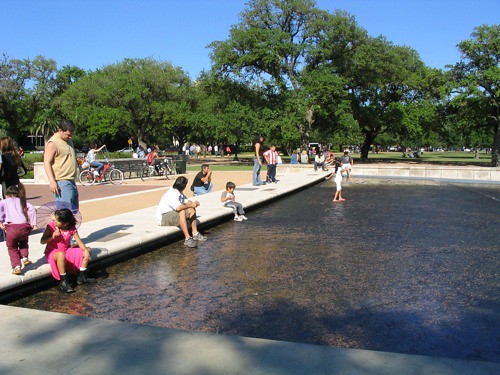Yorkville – Beauty and the Beast
Photo (above): View east from parking garage along alley between Yorkville Ave and Cumberland St, in Yorkville west of Yonge, showing Metro Reference Library, rooftop patio of The Pilot (the Flight Deck) and other buildings in the Yonge-Bloor area, Toronto. Night view (below).
It’s that time of year again, when the TIFF turns Yorkville into a glitzier, crazier, and more bustling place than it already is. While moments of peace may be harder to find during the Festival, it’s worth reflecting for a moment on the heterogeneous beauty of the Yorkville area and how in some ways it represents the genius of Toronto’s urban character. While many people have been upset at the recent intense condo and hotel development in the area, a large number of the older, small-scale characterful buildings have so far survived, giving the neighbourhood one of the most interesting and diverse mixes of building type and building use in the city.
While the logic of density on a subway line might indicate that all of the low rise buildings that still line much of Yonge, Cumberland and Yorkville must inevitably give way to much taller building forms, I think it’s a mistake to deliberately cultivate this state of events since the character and charm of Yorkville revolves around its scale and that scale can easily be irrevocably lost through over-development, particularly if it happens during one, relatively brief building cycle.
On the other hand, I equally think it’s pointless to attempt to “freeze” a neighbourhood at one point in time, at a single density, existing uses, or existing building forms, since to do so is to in many ways prevent the area from evolving and, if done too early, would prevent an area from developing a mix of uses and building types and forms in the first place. It’s one of the trickiest balancing acts in urban design and planning, and so far Toronto has managed to walk this tight-rope in a relatively decent and humane way. Whether continuing with the same policies indefinitely will continue to deliver interesting mixed neighbourhoods like Yorkville is another question entirely, as is the different dynamic that develops when areas become extremely successful and overpriced, sometimes forcing radical changes to the urban fabric.
Photo (above): Tent erected for temporary club/dancehall for Toronto International Film Festival on future site of new Four Seasons Hotel at Bay St and Yorkville Ave. Night view (below).
The flip-side of the Yorkville story is the (beastly?) craziness of the TIFF, this year neatly exemplified by the temporary tent/club/dancehall erected in the parking lot behind the sales centre for the new Four Seasons hotel and condo development at Bay St and Yorkville Ave. How this club (whose entrance seems to be through the sales centre) is related to the hotel and condos is perplexing at this point, but it has made for an interesting addition to the streetscape and nightscape – particularly the eeriness of the blue-purple pulsating lights and deep base emanating from the transparent roof of a party that would normally be wholly invisible to the outside world.











































